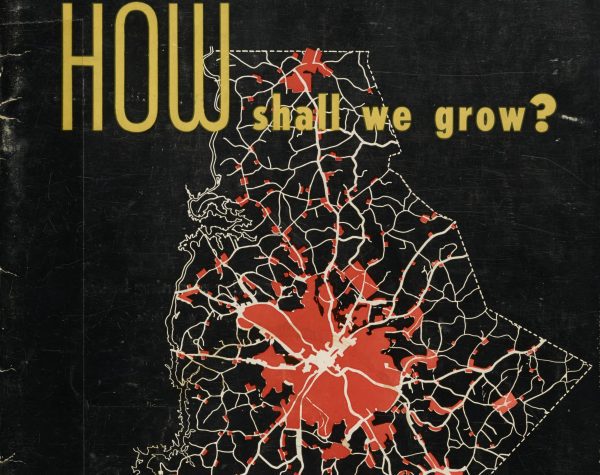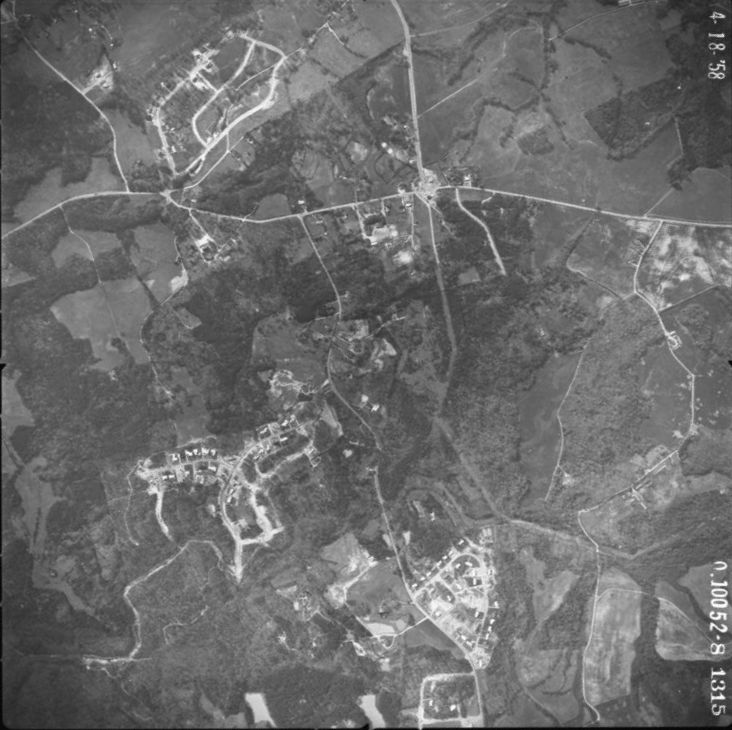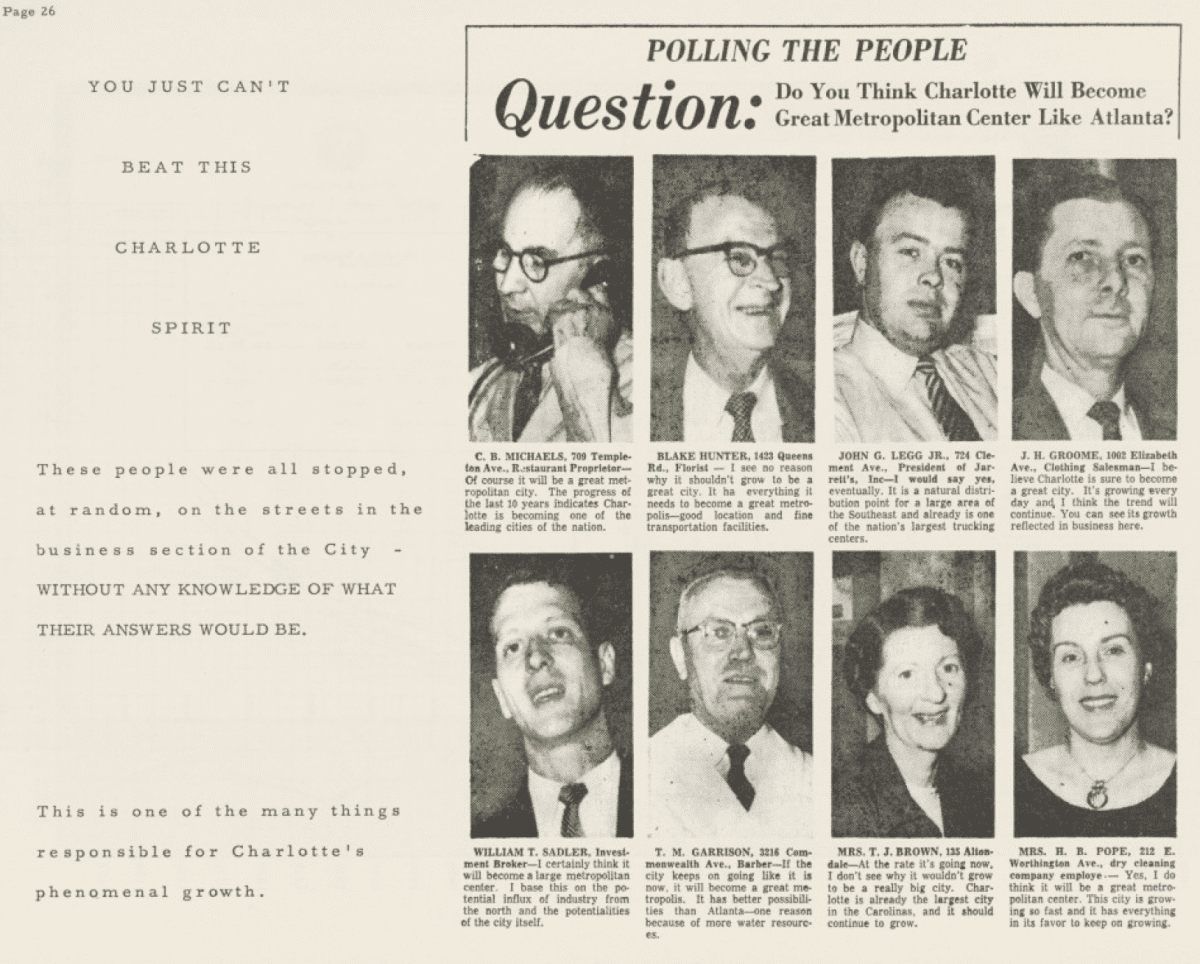How should Charlotte grow? Decades-old study points to some lessons worth remembering.

“How shall we grow?”
That question was the dramatic title of a 1955 report examining the Charlotte region’s breakneck growth (Almost 200,000 residents and 75,000 cars in the county!) and looming challenges. Confronted with worsening traffic, inadequate transportation options, a lack of park space and the fear that growth was running away without a real, comprehensive plan – familiar themes to the city’s residents today – Charlotte and Mecklenburg County leaders hired a consultant and convened a working group to come up with a solution.
“If we have problems now, we can expect more in the future,” the report’s authors warned. “The greatest problem all of us, as citizens of the County, must face today is making certain the community we build keeps pace with the changing needs of our growing population.”
More than five decades later, many of the report’s themes sound eerily prescient. Some of the recommendations – a joint city-county planning board, holding hearings on rezoning requests before City Council – were carried out, and are with us still. Others read like warnings that weren’t acted upon – anyone who’s complained about sitting in traffic on Interstate 77 will wince reading the recommendations about solving transportation problems before they grew intractable.
(The report is available at the J. Murrey Atkins Library archives. You can read read the full report for free online.)
So is there anything to be gained from a decades-old appraisal of booming Charlotte? Here are four lessons we can draw from the “How Shall We Grow?” report almost 55 years later:
Charlotte’s big problems aren’t new.

The area of Fairview and Sharon roads in 1958. Photo: NCDOT aerial archives.
Crowded schools. Not enough park space to meet the growing population’s needs. Traffic. Inequality. Sprawling development. These might seem like questions of our time, but Charlotteans were worried about the same stuff in 1955.
“The rapid growth of our county in the last 50 years – with more people, more homes, more streets and roads, and more of all the physical elements that make up a modern community – has brought with it many problems,” the report’s authors wrote.
For example: There were 19,000 students in schools designed to hold just 16,000. Segregation laws meant separate schools would need to be built for black and white students. To meet national standards, the city should have had 1,100 acres of public parks for its residents – but Charlotte possessed only 460 acres, less than half the recommended total. And with one in three residents now owning a car, traffic was a growing problem.
The report asked a question about planning for all this growth: “Can we afford to repeat the mistakes we have made in the past?”
Be wary of grand plans promising a simple solution.
“Urban renewal,” “slum clearance” and “blight” were hot topics in the 1950s, 60s and 70s, viewed by local leaders as a panacea for the city. Charlotte officials were unabashedly enthusiastic about the prospects of tearing down “blighted” areas downtown and reshaping them, in part by condemning land and reselling it to private developers.

The Charlotte Redevelopment Commission signs its first land purchase deal, buying part of the Brooklyn neighborhood, in 1961. Photo: UNC Charlotte archives.
“The Charlotte Redevelopment Commission has the authority to acquire the blighted areas, clear the land and improve the sites,” the report boasted, “so that private developers can put the land back into profitable use.”
The biggest area that was cleared: Brooklyn, an African-American neighborhood home to thousands in what’s now Second Ward. The neighborhood was a diverse mix of residents from all income levels, from impoverished families to professionals and business owners.
Local leaders, however, saw Brooklyn as a malignancy that had to be excised so the city could thrive. Instead of working to fix up the more run-down housing and help low-income residents, they opted for the quicker, grander fix and called in the bulldozers.
“Never much to begin with – with its shotgun houses and shoddy store buildings, jammed together, over stagnant creeks, on ill-planned streets and dingy alleys – Brooklyn was ugly, fetid, dangerous, worn out beyond repair,” reads another report, “A Better Charlotte Through Urban Renewal,” from 1966, reflecting the condescending attitude of its time.
And beneath that, there was a hunger for the land Brooklyn families and businesses occupied: “Furthermore, it was apparent that land would soon be needed on which to build new city and county buildings.”
Mayor Stan Brookshire triumphantly swung a sledgehammer to knock down the first house, and demolition crews followed his lead with gusto. The federal government funded two-thirds of the urban renewal projects’ cost, with local governments kicking in the other third.
Two decades later, the Brooklyn neighborhood had been wiped off Charlotte’s map, bulldozed and replaced with the Government Center, hulking municipal buildings, underused Marshall Park and the central jail. “Urban renewal,” touted as the fix to all kinds of social ills by Charlotte’s leaders, is now viewed as one of the biggest mistakes in the city’s past, wiping out a lively neighborhood and displacing thousands of vulnerable residents.
Mecklenburg County is trying to undo the legacy of urban renewal with the Brooklyn Village project, which would bring offices, a hotel, shops, restaurants and over 1,000 residences to the sterile, quiet Second Ward. But that project has run into its own obstacles, and the site’s future is still unclear.
Planning for growth is hard – especially in the midst of it
Anyone following Charlotte’s efforts to rewrite its development ordinances and come up with its first comprehensive plan in decades will recognize the following exasperated tone from 1955: “The planning that is being done in the city is being done by particular departments or agencies, with reference to particular problems…Our plans, excellent in themselves, have been piecemeal. They have considered problems separately without relating them one to the other.”
A graphic put it in stark terms: “HAPHAZARD OR PLANNED GROWTH?”
[Read more: Charlotte looks ahead two decades to plan growth]
Almost 55 years later, planners are still trying tom come up with a comprehensive blueprint to guide the city’s growth. The city is in the midst of what’s planned to be a decade-long rewrite of its development rules, started in the early 2010s. The current effort is seeking to unify the hodgepodge of dozens of plans and regulatory documents – covering everything from individual small areas to the tree ordinance to stormwater to zoning rules – into a single development ordinance, guided by a master plan. Called Charlotte Future 2040, city leaders hope to implent the new comprehensive plan in 2021.
Growth – and boosterism – remain abiding strains of the Charlotte DNA

“YOU JUST CAN’T BEAT THIS CHARLOTTE SPIRIT”: Featured in a 1955 city packet promoting Charlotte bonds, this page shows the results of eight Charlotteans stopped “at random” to answer the following question: “Do you think Charlotte will become a great metropolitan center like Atlanta?” Unsurprisingly, all eight said yes. Source: UNC Charlotte archives.
The growth Charlotte was experiencing in 1995 seemed wondrous to many. It was a source of civic pride. In 2019, that’s another familiar story for Charlotteans.
“Mecklenburg County and Charlotte symbolize the New South – a region whose twentieth century industrial and urban growth has attracted the attention of the nation,” the authors of “How Shall We Grow?” proudly wrote.
“The city is growing, and all indications are that it will continue to grow for several decades to come,” they noted, adding that the county’s population increase from 1920 was more than the total populations of Hickory, Gastonia, Albemarle, Monroe, Statesville, Salisbury and Concord.
Looking ahead, they noted that if the growth rate continued, it would “be as if we were to pick up Asheville, Greensboro and Winston-Salem and move them into the county.”
Was such a boom even possible, the report’s authors asked?
Their answer: “Incredible as this rate of growth may seem, it has happened before to Mecklenburg and it could happen again.”